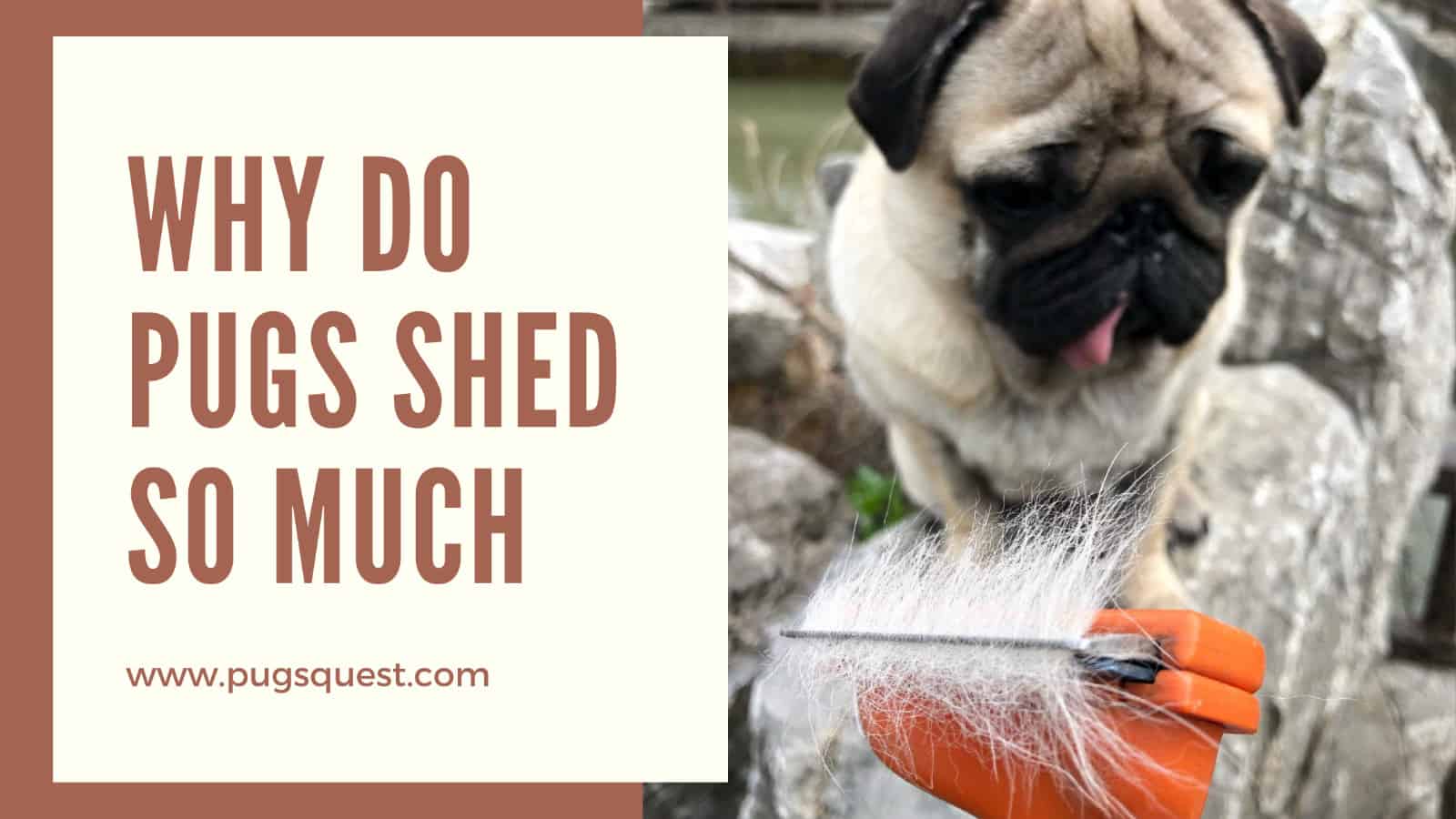Pugs make out-of-this-world sweet, laid-back, gentle companions. But before you decide on getting a pug, you should make sure they fit your lifestyle, your needs, and your wants.
One question that begs an answer is, do pugs shed?
In this article, we’ll be answering:
- Do Pugs shed and why they shed a lot
- How much do pugs shed
- How to reduce Pug shedding
- And more
Let’s dive in…
Do Pugs Shed? Why Do Pugs Shed So Much?
Yes! Pugs shed a lot.
Pugs are considered to have originated in China, but there is evidence that suggests they originally came from Tibet, where the extreme cold weather meant that only the dogs with the thickest, most insulating coats were selected for breeding.
For this reason, many pugs today have a double-coat, which means they shed almost twice as much as most dogs.
In fact, pugs are known to be “a lot of dog occupying very little space”, which seems exceptionally fitting for their dense coats.
There can be as many as 600 hairs per square inch in a pug’s coat.
In addition, unlike most dog breeds, pugs shed more heavily year-round, with peaks during fall and spring, as their coat adjusts to the weather with the seasons.
These reasons coupled with their predispositions to allergies and other health-related issues make for heavy shedding that should be taken into consideration before getting a pug.
How Much Do Pugs Shed?
But how much do pugs actually shed?
Well, it varies from dog to dog, but the one universal truth is: a lot.
Here are a few general rules of thumb:
- Black-coated pugs are less likely to have a double coat, which means that they are likely to shed less.
- Female pugs often shed more while they’re in heat.
- Dogs with allergies will shed more than ones without.
- Some medical conditions will make your pug shed more.
- Frequent bathing may remove protective oils and cause more shedding than usual.
- Pugs shed more in the fall and spring, as their coat prepares for more extreme weather.
- Puppies don’t shed as much as adult pugs, with 1-1.5 years old marking the beginning of your dog’s normal shedding amount.
Regardless of all these variants, though, pugs definitely shed more than most dog breeds and range from medium to heavy shedders, so that’s something to take into account when considering adding a pug to your household.
Tips to Help Reduce Pug Shedding
1. Pay attention to the Nutrition for Pugs
A healthy dog sheds less, and nutrition is the #1 factor in a dog’s health.
- When purchasing food, make sure to get omega-acids rich food. Try to get the best food you can afford and you’ll find your pug will be satisfied faster, shed less, and live longer.
- If no quality food is available locally, consider getting dog-specific supplements.
- Look for EPA (eicosapentaenoic acid) and DHA (docosahexaenoic acid) fatty acids, which help your dog’s coat stay healthy and avoid hair breakage, which can cause excessive shedding.
2. Fresh water at all times
While keeping your dog hydrated is important for many reasons, one little-known reason is that dry skin may promote shedding.
- Make sure your pooch has clean, fresh water at all times.
- My favorite way to get my dogs to drink more is to use a water fountain like this one. They are always happier to drink from a fountain than from a bowl with standing water.
- Just make sure to clean it regularly and to keep it topped-off for the best performance.
3. Groom Your Pugs Regularly
The most important thing is to brush your Pug regularly, groom your dog outside is even better, if at all possible.
- Pugs’ have double coats, which means that many times shed hair gets trapped between the coats.
- Make sure you groom your pug regularly, preferably every 1-3 days, so their coat stays clean of debris (which can also irritate your pug’s skin and cause excessive shedding) and loose fur.
- The best tool for the job is the trusty FURminator, which not only de-sheds your pug’s undercoat, it also has a handy FURejector button, which releases hair with ease (you can thank me later). You can also check our best brush for Pugs guide to get more options.
- Bathe your pug, but not too often. A recommended interval is between 3-6 weeks, depending on the weather.
- When you bathe your pug, make sure you use only natural shampoos, like this one, so you don’t remove the protective oils from their coat, which can lead to even more shedding.
4. Care About the Emotional Health
A little-known cause of excessive shedding in dogs is stress.
For some reason beyond my understanding, there are few people discussing the effects of the home environment on your dog’s mental well-being and its relation to physical health, including shedding.
While none of us want to stress our four-legged-friends out, there are several ways in which we may be inadvertently doing just that.
Let’s list the most common ones:
- Leaving your pug for extended periods of time.
Pugs were bred as lap-dogs. As such, their mission in life is… well, you.
You are the center of their attention, the love of their life, and the reason for their existence.
When you leave them alone for more than 10-12 hours per day, they get sad, anxious, and stressed.
One good way to mitigate this situation is to have friends, family or neighbors check in on your dog during the day.
If that’s not possible, consider hiring a dog-walker or putting your dog in doggie-day-care.
- Too many surprises.
While pugs are easy-going and friendly beings (most of the time), too many new things in a short period of time can vex them, like they would any animal.
It’s great to change things up, but don’t introduce too many changes at once or your dog might react negatively and shed more than usual.
This is especially true if the changes are big, like moving to a new home or going on a prolonged vacation.
In those cases, consider leaving your buddy with a trusted caretaker for a while so most of the changes happen out of its sight.
Another great way to mitigate stress-inducing situations is to keep a certain routine so your pug knows what to expect even if their environment changes.
This can be a bed-time routine of eating-playing-cuddling, a morning walk followed by a treat or something else.
Just keep it consistent so your dog has an anchor in their life.
- Difficult situations
This is something most people don’t think of, but your pug picks up on your feelings and on its surroundings in ways we can’t begin to understand.
If your home situation is negative or stressed, whether because of a transition period or something else, your pug may be negatively affected by it.
While there’s no real way to shelter them from those big feelings, you can offer extra affection to try and mitigate the stress (plus, you can never really have too many cuddles, right?).
A set routine helps your dog anchor in this case, too, so that might be another thing to consider.
5. Keep an Eye on Their Physical Health
While this may seem obvious to some, there are several underlying medical conditions that may result in abnormal shedding.
A few signs your dog’s shedding may be abnormal:
- You notice patches of fur rather than individual hairs on your floors.
- Your dog licks or scratches a single spot or area incessantly.
- Your dog already has allergies. In this case, they may be prone to developing a new allergy.
- Your dog recently got stung by an insect (this may result in an allergic reaction).
- Your dog is younger than 1-1.5 years.
- Your dog is less active, has less appetite, and does not act like his usual self.
If you notice any of the above, please consult a veterinarian.
In any case, it is advisable to have a veterinarian examine your pug at least once a year, to rule out underlying physical issues that may promote excessive shedding in your dog and to make sure your dog has a long, good life.
Is Dealing with a Pug’s Shedding Too Much Work?
While it’s impossible to stop your dog from shedding, here are some ideas to help you live with it without suffering:
1. Sweep or vacuum every 1-3 days, so there’s no buildup and no smell. It helps if you have a professional vacuum created for animal fur, like Bissell.
2. Cover your couches so all you need to do to get them clean is launder them.
3. Use a bed cover for the same reason, or get your pooch their own bed to sleep in.
4. Deep clean your washing machine after every “dog” load, so the hair doesn’t build up and sticks to your clothes.
FAQs
1. Do black pugs shed less?
Black pugs are more likely to have only one coat and therefore shed up to half as much as their light-colored siblings (such as fawn, peach, etc).
While this is not guaranteed, the odds will be stacked in your favor if you choose a black companion over a light-colored one.
2. How to keep your house clean with a shedding pug?
Keeping your house clean is easier when you maintain it more often because you don’t have to deep-clean all the time.
With three different shedding dogs in my home, I decided to invest in an iRobot (here is the model I use), so that it does the heavy-lifting for me.
3. Can I stop my pug from shedding?
No, not really. But for the love, loyalty, and affection you get from your pug, shedding might not be as big of a deal as it sounds.
People live with it, and it’s often a sacrifice they’re willing to make to have the best companion a man can ask for.
4. Should I shave my pug?
While shaving is occasionally touted as the ultimate solution to pugs’ shedding, I personally don’t think it makes sense to shave your dog, for multiple reasons.
Firstly, their coat helps protect them from the elements, and by shaving it you’re introducing another risk factor to your pug’s health.
Secondly, shaving also requires high maintenance, averaging around 6-weeks between groomer visits.
It’s not a permanent solution and it also damages your pug’s undercoat.
All in all, I believe the risks outweigh the benefits.
5. Should I spay my pug?
Spaying your female pug is a responsible thing to do if you don’t have any intention to breed her, and it may help with shedding because your bitch will no longer be in-heat.
That said, shedding normally isn’t the primary reason for spaying.
In any case, you should consult a veterinarian before you decide to spay your pug.
6. My pug is shedding excessively, should I be worried?
While pugs normally shed a lot, however, there are some health-related issues that may cause excessive shedding, you should always consult a veterinarian if you are concerned.
Conclusion
At the end of the day, while pugs do shed, they compensate with sweet, playful personalities, loyalty, and love.
I hope you have a better understanding of why do pugs shed.
I’d love to hear from you, what’s one change you’re going to implement today to help your pug?

